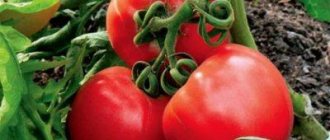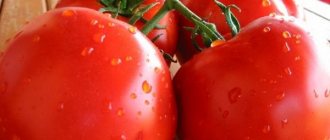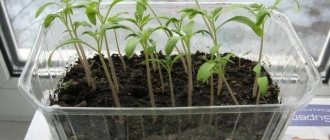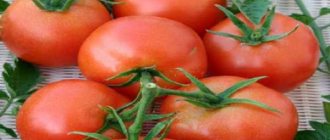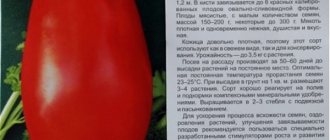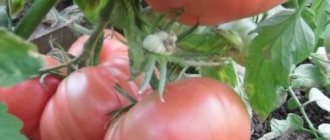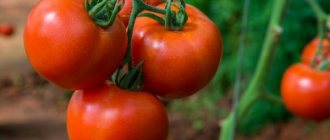It is possible to have delicious tomatoes all summer long. To do this, you just need to choose the right tomato. Belle f1 is a highlight in the tomato world with excellent marketability and rich harvests. It was bred as a professional tomato, but is used everywhere.
| Height | Landing location | Ripening time | Fruit color | Fruit size | Origin | Fruit shape |
| Tall | Greenhouse, Open ground | Mid-season | Reds | Average | Hybrid | Flat-round |
Description of the hybrid
Belle f1 from the Dutch company Enza Zaden was bred specifically for growing in greenhouse and greenhouse conditions in the third light zone of the country. Included in the State Register of the Russian Federation in 2003.
The bushes are indeterminate, branched, with foliage of medium density . The trunks are thick and knotty. The rhizome is well developed.
In the photo - Belle f1 tomatoes.
Reference. The third light zone of Russia includes: Belgorod, Bryansk, Vladimir, Voronezh, Kaliningrad, Kaluga, Kurgan, Kursk, Lipetsk, Moscow, Orel, Ryazan, Sverdlovsk, Smolensk, Tambov, Tomsk, Tyumen regions, Krasnoyarsk Territory, Republic of Bashkortostan, Yakutia, Republic of Tatarstan, Republic of Khakassia.
Distinctive features
The table shows the main characteristics of the hybrid.
| Indicators | Characteristic |
| Weight | 121–145 g (up to 180 g) |
| Form | Flat-round, slightly ribbed |
| Coloring | Red |
| Leaves | Medium size, green |
| Type of inflorescences | Simple |
| Number of slots | Four or more |
| Pulp | Juicy but not watery |
| Taste | Sweet and sour, pleasant |
| Skin | Glossy, dense |
| Purpose | For salads, preserves, sauces and pasta |
| Bush height | 1.5 m |
| Ripening period | 107–115 days after germination |
| Productivity | 27–31 kg/m² |
| Sustainability | Tobacco mosaic virus, fusarium, verticillium |
| Transportability | High |
Growing seedlings
Seeds are sown 60–65 days before planting in the ground . Work begins in the second - third ten days of March.
Soil preparation and sowing
Seed material does not require preliminary disinfection and soaking in growth stimulants. The seeds have been processed in production.
For seedlings, take universal soil from a gardening store or prepare a soil mixture with your own hands. To do this, mix one part of peat, humus, turf, river sand, wood ash in a large container and add one tablespoon of superphosphate. The substrate is calcined in the oven or sprinkled with potassium permanganate for disinfection.
Containers for seedlings (pots, plastic trays) are filled with moist soil , a depression of 1.5–2 cm is made and the seeds are laid out at a distance of 2 cm. Then they are sprinkled with earth, covered with film and the containers are left in a dark place.
After the sprouts appear , the film is removed and the seedlings are taken to a well-lit place.
The seedlings are watered with warm, settled water , strictly at the root, with a pipette or syringe.
Picking is done after the appearance of 2-3 leaves in 2 liter pots. In 60 days, the seedlings stretch quite strongly, so they need spacious containers to form a strong root system.
Before planting in the ground, seedlings are fertilized three times with minerals.:
- For the first feeding after picking, use 2 tbsp. l. nitrogen per 10 liters of water or the preparation "Agricola".
- The second feeding is applied 12 days after picking. Take 0.5 tbsp. l. nitroammophoska per 5 liters of water. For one seedling – 100 ml.
- A week before planting, fertilize with potassium and phosphorus: 1 tsp. superphosphate, 1 tbsp. l. ash per 5 liters of water. For one seedling - 0.5 tbsp. solution.
How to grow
For successful cultivation of Bella Rosa, the manufacturer recommends following a number of rules:
- disinfection and germination of seeds before sowing;
- simultaneous stepsoning and gartering;
- removing side shoots 4-5 cm long until the first cluster appears;
- forming bushes in dry weather conditions to avoid fungal infection;
- moderate watering;
- compliance with the fertilizer application schedule (once every 3-4 days);
- prevention of bacterial diseases.
Sowing seeds
Seed material begins to be planted at the end of March or beginning of April, approximately 60 days before planting in open ground.
The seeds are disinfected in a pale pink solution of potassium permanganate for 30 minutes. Pre-germination helps to increase the percentage of germination. The seeds are laid out in one layer on one half of damp gauze, the other is covered and left for 2-3 days. The fabric is periodically moistened with warm water using a spray bottle.
For sowing, plastic containers, tetrapacks, and pots are used. Any soil for seedlings is suitable: from the garden or universal for growing flower plants. Drainage is poured into the bottom of the containers, then soil. Make furrows 1 cm deep and lay out the seeds at a distance of 2 cm. Cover with a thin layer of earth, water with a watering can and cover with plastic wrap.
Advice. It is recommended to pre-disinfect the soil from the garden in the oven.
Seedling care
Containers with future seedlings are placed in a shaded place, the film is removed from time to time for 10–15 minutes so that the soil does not become moldy. After the sprouts appear, the containers are taken to a well-lit place. If there is not enough sun, a phytolamp is additionally used. Moderate watering is necessary, the air temperature should not be lower than +15 ° C, otherwise the leaves will turn purple.
Planting into individual containers begins when the first true leaves appear. Peat cups are best suited; seedlings are planted directly into the ground in them.
Planting ready seedlings
The soil for planting seedlings begins to be prepared in the fall. The soil is dug up and weeds are removed along with their roots.
The transfer of seedlings is carried out in early May, making sure that the soil has warmed up sufficiently and the threat of frost has passed. The growing area must be sufficiently lit. Mullein is used as fertilizer. The holes are dug to a depth of 10–15 cm and filled with a solution of potassium permanganate. Planting density – 4 bushes per 1 m², distance – 50 cm.
Agricultural technology of tomatoes
The Dutch hybrid loves loose and nutritious soil . The culture grows well in any climatic conditions and withstands cold, heat and lack of sunlight. Even novice gardeners do not have any particular problems with caring for tomatoes.
Landing
Before planting seedlings, the soil is fertilized with compost, peat, sawdust and humus. The holes are dug to a depth of 10 cm and filled with boiling water for disinfection.
The bushes are slightly buried to ensure the development of additional lateral roots. The soil is covered with mulch so as not to bother yourself with constant loosening after each watering. To do this, use peat or sawdust. Mulch perfectly retains moisture in the soil, serves as additional protection against bacteria, and prevents the growth of weeds.
An important condition for the successful cultivation of Belle f1 tomatoes is the correct formation of bushes into one stem. Within 10–12 days after planting, remove excess shoots. The first inflorescence is formed above the ninth leaf, the subsequent ones - after three leaves.
The bushes are watered abundantly only for the first week after being transferred to the ground . Then the tomatoes are given moderate watering. The soil should dry out slightly before watering the plants again, but it is important to prevent the leaves from wilting.
Every 14–21 days, tomatoes are fertilized with complex mineral compounds:
- The first feeding is 14 days after planting. To do this, use a solution of one part mullein and five parts water.
- The second feeding is three weeks after the first (20 g of potassium salt, 20 g of superphosphate diluted in 10 liters of water).
- During flowering, tomatoes are fed with boric acid at the rate of 2 g of the substance per 2 liters of water.
- During the period of fruit appearance, potassium-phosphorus fertilizer is used (20 g of potassium salt, 20 g of superphosphate per 10 liters of water).
Prevention of diseases and pests
Hybrid Belle f1 is resistant to tobacco mosaic virus, fusarium, and verticillium, but has no immunity to late blight. When infected, brown spots appear on the leaves, stems, and soon on the fruits. If measures are not taken in time, there is a risk of being left without a harvest.
Folk remedies help fight late blight (per 10 liters of water):
- 1 cup chopped garlic and green shoots, 2 g potassium permanganate;
- 1 cup rock salt;
- 1 liter of kefir or whey;
- 1 liter of milk, 20 drops of iodine;
- liter jar of ash, 50 g of laundry soap shavings.
The resulting solutions are used to irrigate the bushes before the formation of ovaries , then every 14 days. The drugs “Quadris”, “Quadro”, “Consento” act quickly. Biological agents “Fitosporin”, “Planriz”, “Baktofit” are safer, but less effective.
, Aktara, Epin, and Zircon products will help fight insects such as
Advantages and disadvantages
The hybrid has a number of undeniable advantages :
- suitability for low-volume cultivation technology;
- high productivity;
- excellent presentation;
- large fruits;
- resistance to adverse weather factors, including lack of sunlight;
- early maturation;
- wonderful taste;
- excellent keeping quality;
- resistance to tomato diseases.
The disadvantages of a hybrid are insignificant:
- the seeds are not suitable for re-use in the next season, since they do not inherit the maternal genes;
- tall bushes need staking and shaping.
Reference. Low-volume technology is a method of cultivating tomatoes without the use of soil on an industrial scale. Main advantages: there is no need to use agricultural technology to till the soil, no chemicals to protect against diseases and pests. Thus, the quality and environmental friendliness of vegetables increases.
Interesting
With low-volume technology for growing vegetables, the soil is replaced with mineral wool and peat, and food and water are supplied to the plants using drip irrigation. On an industrial scale, this method is increasingly replacing traditional vegetable growing.
The tomato variety Belle f1 was tested by our vegetable growers in ordinary garden soil and received excellent reviews.
Farmer reviews
Hybrid Belle f1 has received recognition and high praise from farmers due to its ease of care and wonderful taste.
Leonid, Slavsk, Kaliningrad region. : “I’ve been growing a hybrid since 2010. The harvest is always excellent, the quality of the fruit is high. The bushes are tall, the brushes are powerful, every 3-4 leaves. I applied mineral fertilizers frequently and watered moderately.”
Sofia, Livny, Oryol region. : “I planted Bella tomatoes last year. I was surprised by the abundant fruiting. Whole bunches of tomatoes formed on each bush. There were no difficulties in care; the soil was fertilized with compost and peat. There was even no late blight. The tomatoes are very tasty, sweet and sour, juicy.”
Reviews
“I started growing this tomato hybrid in 2006. In the first year I received an excellent harvest. I was surprised that the bushes grew very tall, I had to add height to the supports, but it was worth it. Every three or four leaves hung a powerful bunch of tomatoes. I didn’t skimp on mineral fertilizers; all the “Dutch” people love fertilizing.”
“I read about the Belle variety in a magazine four years ago. I immediately took note and tried it next season. The tomato did not disappoint, it grew 2 meters high and was “covered” with tomatoes to the eyeballs. I didn't notice any particular difficulties. I grow vegetables in a greenhouse and fertilize the garden soil with peat and compost. Bella liked this soil and there were no illnesses. I liked the taste of the tomatoes, moderately sour and sweet. I’ve been growing Bella for the third season for myself and for sale.”
Description and characteristics of tomato Belle F1, reviews, photos
Mid-early (107-115 days period from germination to ripening), tall, cluster tomato hybrid from Dutch breeders. Recommended for growing in greenhouses.
The plant is indeterminate (with unlimited growth), medium-leaved, requires tying to a support and pinching. Medium sized leaf, green. The inflorescence is simple. The first inflorescence is laid above the 9th leaf, the subsequent ones - after 3 leaves. The manufacturer recommends forming this tomato bush into 1 stem, removing all the side shoots.
Basic qualities of fruits
The fruits are round, slightly ribbed at the stalk, glossy, at the ripe stage of rich red color, weighing 120-180 grams, good taste. Not prone to cracking, durable and transportable. These tomatoes are universal in purpose - suitable for both fresh consumption and processing.
Advantages of the hybrid : high yield and marketable quality of fruits, resistance to low light. The hybrid is resistant to tobacco mosaic virus, fusarium, and verticillium.
In 2003, the Belle F1 tomato was included in the State Register of the Russian Federation for cultivation in an extended rotation in a small-volume crop.
Originator : Enza Zaden (Holland).
In Russia, the seeds of this variety are packaged.
Bush formation
One of the main points of caring for the Belle f1 tomato is the proper formation of the bush. The hybrid is grown in one stem, being sure to remove all excess shoots every 8-12 days. The first inflorescence is usually formed above the 9-11th leaf. Then the tomato blooms every 3-4 leaves.
See also
Characteristics and description of tomato varieties of the Gnome tomato series, its yieldRead
Advice
In open ground, it makes no sense to let tomatoes form more than 4-5 clusters; the rest usually do not have time to ripen before the onset of cold weather and only interfere with the ripening of the crop.
Therefore, at the end of July, the upper part of the bush is cut off, leaving a few leaves above the last inflorescence. The leaves under the ovary are thinned out, yellowed and dry ones are regularly removed, preventing the planting from becoming dense.
The bushes provide strong support by starting the first garter immediately after the first flowers appear.
Features of cultivation, planting and care
It is recommended to sow seeds for seedlings 60-65 days before the intended planting in the ground. The seedling is picked at the stage of two true leaves. When planting seedlings in a permanent place per 1 sq. m plot place up to 4 plants. Planting pattern : 50 x 40 cm.
Further care for tomatoes consists of timely watering, fertilizing, removing weeds and shoots, and preventive measures to protect plants from diseases and pests.
If you grew Belle f1 tomatoes, please write what the yield and taste of the fruit was under your conditions? What was the height of the bush? How do you rate the disease resistance of this tomato? If possible, attach a photo of the entire bush or individual fruits you grew.
Your reviews of the Belle F1 tomato, as well as additions to the description, will help many gardeners evaluate this hybrid objectively and decide whether it is worth planting or not.
Seedling
Seedlings are sown 60-65 days before the planned planting in a permanent place. Belle f1 tomato seeds are of excellent quality, have increased germination and do not require pre-sowing preparation or soaking.
Important!
The “f1” marking indicates that the variety is a hybrid and is not suitable for self-harvesting seeds, since they do not retain varietal qualities.
In the phase of 1-2 true leaves, the seedlings dive into separate pots with a volume of at least 2 liters. The Belle variety is interdeterminate; in 2 months the bushes will grow quite large. It is important to provide plants with a normal volume of soil to form a complete root system. Feed the seedlings 2-3 times with complex mineral fertilizers.
If you plan to grow tomatoes in open ground, then at the age of 5 weeks they begin to harden the seedlings.
